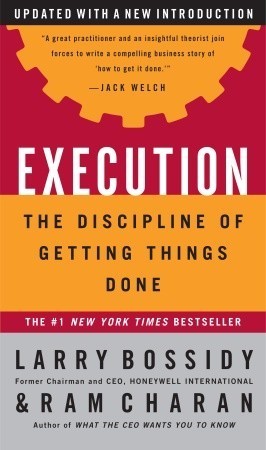More on this book
Community
Kindle Notes & Highlights
In its most fundamental sense, execution is a systematic way of exposing reality and acting on it.
You need robust dialogue to surface the realities of the business. You need accountability for results—discussed openly and agreed to by those responsible—to get things done and reward the best performers. You need follow-through to ensure the plans are on track.
The leader must be in charge of getting things done by running the three core processes—picking other leaders, setting the strategic direction, and conducting operations. These actions are the substance of execution, and leaders cannot delegate them regardless of the size of the organization.
His personal involvement in that architecture is to assign the tasks and then follow up.
“Unless I can make this plan happen, it’s not going to matter.”
Third, Joe would have set milestones for the progress of the plan, with strict accountability for the people in charge.
People who fall short have to explain why, and what they are going to do about it.
Know your people and your business. Insist on realism. Set clear goals and priorities. Follow through. Reward the doers. Expand people’s capabilities. Know yourself.
And when we ask what they’re going to do about the weaknesses, the answer is rarely clear or cohesive. They say, “We have to make our numbers.” Well, of course you have to make your numbers; the question is how you are going to make your numbers.
The same principles apply to coaching an individual privately. Whatever your style—whether it’s gentle or blunt—your aim is to ask the questions that bring out the realities and give people the help they need to correct problems.
Education is an important part of expanding people’s capabilities—if it’s handled right.
the best learning comes from working on real business problems.
Self-mastery is the key to true self-confidence.
Making mistakes is inevitable, but good leaders both admit and learn from them and over time create a decision-making process based on experience.
it’s not useful to beat other people up when they make mistakes. To the contrary, that’s the time to coach them, encourage them, and help them regain their self-confidence.
The behavior of a business’s leaders is, ultimately, the behavior of the organization. As such, it’s the foundation of the culture. In the next chapter, we present a new framework for changing the culture of an organization. CHAPTER 4
First you tell people clearly what results you’re looking for. Then you discuss how to get those results, as a key element of the coaching process. Then you reward people for producing the results. If they come up short, you provide additional coaching, withdraw rewards, give them other jobs, or let them go. When you do these things, you create a culture of getting things done.
We’ve seen again and again that people love to give rewards; they love to be loved. But they don’t have the emotional fortitude to give honest feedback and either withhold a reward or penalize people.
“There were no negative consequences for poor performance,”
You’ve got to realize, EDS is improving, and everybody’s got to improve the job they do, and if you’re staying the same, you’re falling behind.’”
Other leaders design rewards for new behaviors of execution but implement them brutally. They don’t take the important step of helping people to master the new required behaviors. They don’t coach.
“Truth over harmony.”
To build an execution organization, the leader has to be present to create and reinforce the social software with the desired behaviors and the robust dialogue. She has to practice them and drill them relentlessly in the social operating mechanisms.
What they’re overlooking is that the quality of their people is the best competitive differentiator.
If the nonperformer is high enough in the organization, he can destroy it.
As noted earlier, leaders need to commit as much as 40 percent of their time and emotional energy, in one form or another, to selecting, appraising, and developing people.
If you spend the same amount of time and energy developing people as you do on budgeting, strategic planning, and financial monitoring, the payoff will come in sustainable competitive advantage.
in most companies people regard a good leader as one with vision, strategy, and the ability to inspire others.
They don’t ask the most important question: How good is this person at getting things done?
You’re searching for people with an enormous drive for winning. These people get their satisfaction from getting things done. The more they succeed in getting things done, the more they increase their capacity.
I’m wary about hiring him for an important leadership job. He’s likely to pick people like himself, and you’ll have to ring a bell to wake them up. I want people who arrive in the morning with a smile on their faces, who are upbeat, ready to take on the tasks of the day or the month or the year.
Too many leaders think they can create energy by giving pep talks, or painting an uplifting picture of where the business can be in a few years if everybody just does their best.
Decisiveness is the ability to make difficult decisions swiftly and well, and act on them.
Few tough issues are more challenging for indecisive leaders than dealing with people they’ve promoted who are not performing.


